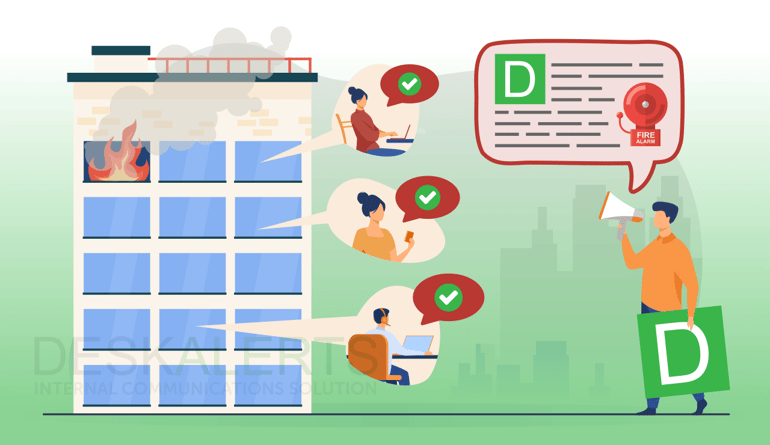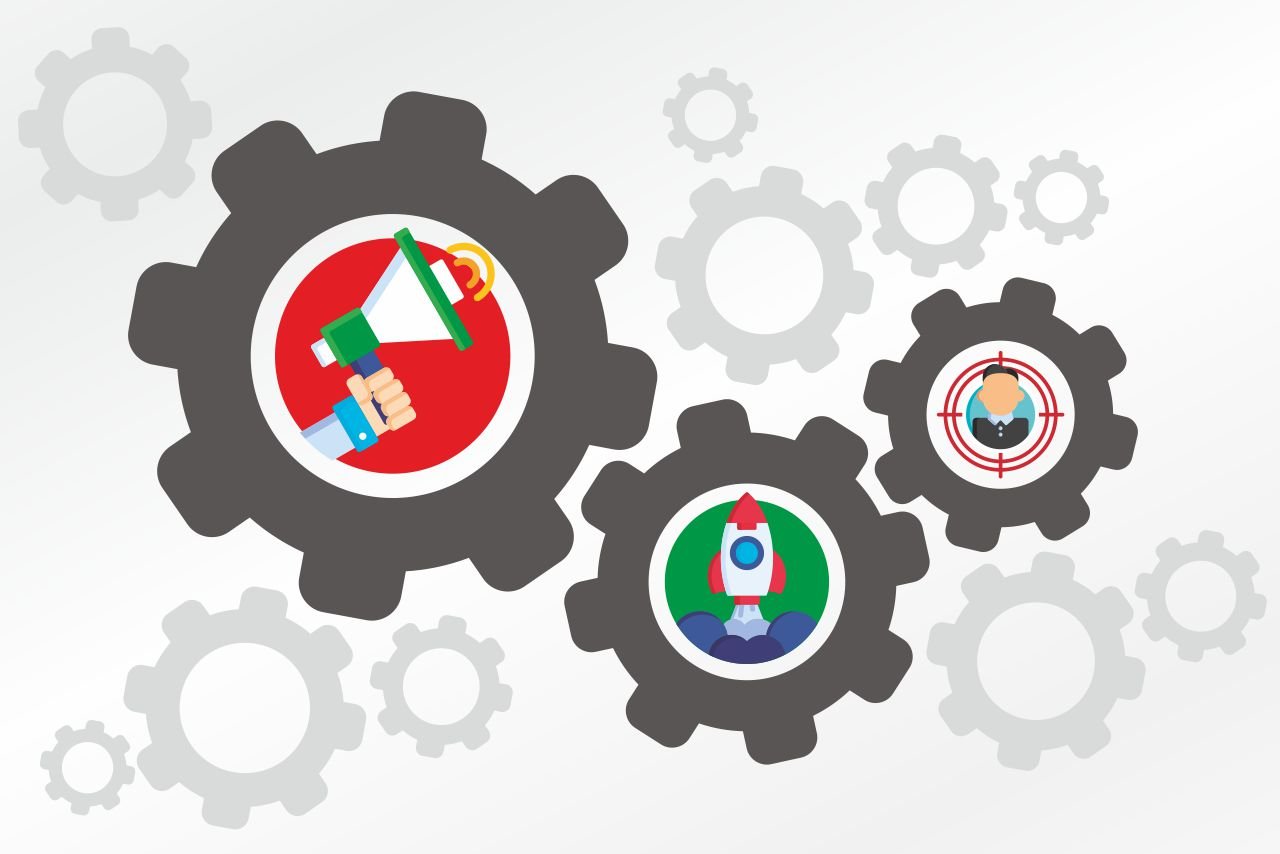
It’s easy to stay calm while everything is going well at work. It’s easy to feel safe on a regular workday. However, how do you handle an emergency at work when it does occur? What do you do on those rare occasions that something seriously goes wrong in the workplace? Is your training enough when it comes to responding to emergency situations? Can your alerting system keep your employees safe and protected?
An important part of keeping safe in the workplace (and anywhere else) is emergency preparedness so that you know how to handle an emergency situation when it arises. Your company should have different action plans and strategies when dealing with various types of emergencies in the workplace (such as fires, storms, and even terrorist attacks).
Be prepared for any emergency with 10 prewritten message templates for fires, lockdowns, on-site shootings, chemical spills, and more → Get Your Free Templates.
What is a workplace emergency?
A workplace emergency is one in which unforeseen circumstances pose a threat to your workplace in some capacity. It might be a threat to your employees, your customers, your premises or all of the above. It may be a threat to life, safety or the continuity of business operations.
Different types of workplace emergencies you may need to handle include:
How to prepare for emergencies in the workplace
Here are the following things you need to tick off your checklist so that you know how to handle an emergency situation in the workplace:
1. Have a working and effective alerting system
There are tons of systems available in the market that you can choose from that help you with how to respond in an emergency situation. Choose the most appropriate one that suits your organization’s needs and requirements.
While an alerting system can have different features, what is important is that it works. An emergency communications system is critical to your emergency preparedness. Invest in an effective system that can notify your employees of the emergency as well as give them instructions on what to do.
DeskAlerts can be used as an emergency notification system to send urgent information to employees. It works by sending emergency alerts quickly to employees’ devices with information about what they need to do to be safe. Emergency notifications will appear on company computer screens no matter what the employee is doing on the computer at the time and will also show on locked computers or computers in standby mode.
DeskAlerts can also send emergency communications to other digital screens in the building, to mobile phones and tablets.
It can also be used in conjunction with other emergency systems such as disaster alarms, tornado warning sirens and the color code alerts that hospitals often use. Employees can be informed in seconds, making it a must-have tool for handling a workplace emergency.

10 Ready-to-Send Emergency Messages You Can Use Instantly
From fires and active shooters to natural disasters and terrorist attacks, these templates help you communicate fast, clearly, and without second-guessing. Download your copy and use it in DeskAlerts.

2. Have an assigned emergency preparedness manager or leader
While managers for each team should be asked to be responsible for the staff members under them, you may also opt to assign other team members should their manager be absent.
The emergency preparedness manager or leader is the one who immediately gets notified by management through an alerting system that an emergency has occurred. They are also knowledgeable regarding emergency and evacuation procedures. They should be calm in times of emergencies. This is extremely important as the lives of other staff members are in his or her hands.
3. Know where emergency equipment and first aid kits are located
Before fires break out, you have to know where the fire extinguishers are located. Knowing this is essential for how to handle an emergency situation and helps you move and react quickly in order to put out the fire and lessen the intensity of the incident.
Before medical emergencies occur at work, you should know what number to call and where the first aid kit is. This lessens the time of searching for what you need and the time you take from finding the kit to tending to the person who needs your help.
Aside from first aid kits and fire extinguishers, other important emergency tools also include break-glass alarms, safety showers, chemical spill control materials and eye wash stations.
Make sure that you know how to operate these tools before using them as you may do more harm than good if you do not use them properly.
4. Be aware of emergency and evacuation plans, and know where the emergency exits are
Organizations are required to inform their employees regarding emergency plans and exits so they also know how to respond in emergency situations. This knowledge is further ingrained in employees through training sessions and practice drills. Make sure that you pay attention when you are being given these very vital details as knowing these may just save your life. Do not take information such as this for granted.
5. Learn CPR
While some people tend to only take up CPR when their jobs or roles require it, you never know if your knowledge of it can save a life.

What to do in the event of a workplace emergency
How to handle an emergency situation? A work emergency can happen with no warning, so the best thing your company can do is be prepared. When an emergency situation unfolds in your workplace, your immediate priority should be the safety of your employees.
Steps you need to take in an emergency at work include:
- Follow any emergency procedures that you have put in place, including any emergency alert steps.
- Contact the appropriate emergency services
- If evacuating, do so in an orderly and calm manner. Take a first aid kit. Ensure everyone is accounted for.
- Check in with the people who are on your emergency contact lists
- Be aware of any risks that the emergency situation is posing
- Follow the directions of law enforcement or other first responders.
***
Don’t assume that your business is immune from emergency situations: they can happen in any place at any time. Being prepared is one of the most important things you can do in advance to ensure your employees are safe.
FAQs
What are the three steps of handling emergencies?
There are three basic first steps that can help you with how to respond to emergency situations. These are:
- Checking the scene of the emergency as well as the victim. Checking the scene first is important so that you can avoid hazards and don’t also end up as a casualty.
- Call the appropriate emergency services
- Provide appropriate care for the victim until the emergency services arrive.
What are the methods of handling an emergency?
If you’re not sure how to handle an emergency situation, the best thing you can do is to contact emergency services straight away to get the appropriate assistance.
To make the call, you should:
- Remain calm
- Call the emergency services number
- Tell the operator who you are and where you are
- Explain the situation and if there are people who are hurt, tell them how many
- Listen to the operator’s instructions and follow them carefully
- Hang up when the operator says it is okay to.
What are the five guidelines for action in an emergency situation?
There are five steps that are considered to be best-practice that should be taken in the management of an emergency. They are:
Prevention – the steps that are taken to avoid an incident or accident from occurring in the first place
Mitigation - these are measures that can reduce the risk of an emergency happening
Preparedness – the activities that are carried out to be ready to respond in the event that an emergency at work occurs
Response – the actions that are taken immediately before, during and after emergencies in the workplace to save lives and reduce loss and damages.
Recovery – the actions that take place in the aftermath of the work emergency situation to restore services and return to normal conditions.
What are the 4 steps of basic emergency procedures?
The four steps of basic emergency procedures are:
- Remain calm and assess the situation. This is important to ensure you can think clearly and make sound decisions.
- Call for help if necessary. If you are unable to handle the situation yourself, call an emergency number.
- Take action to protect yourself and others. This may involve evacuating the area, taking shelter, or providing first aid.
- Follow instructions from emergency personnel. Once emergency personnel arrive, follow their instructions to ensure the safety of everyone involved.
It is important to remember that these are just general guidelines and any specific steps you must take can vary depending on the specific emergency situation.
What are the 5 priorities when dealing with an emergency situation?
The five priorities when dealing with an emergency situation are:
- Assessing the situation - take a quick look around to see what is happening and be aware of any potential dangers.
- Calling for help - if you need assistance, call the appropriate emergency number.
- Securing the scene - make sure the area is safe for both you and any casualties.
- Providing first aid - if there are any injured people, provide first aid as needed.
- Remaining calm - it’s important to stay calm in an emergency situation so ou can think clearly and help others.
It is also important to remember that the priorities may change depending on the specific situation. For example, if there is a fire, the first priority may be to evacuate the building.
What are at least 4 principles of emergency care?
These are four general principles of emergency care - specific care that is given to a patient will vary depending on their individual needs:
- Scene safety. This means assessing the scene of the emergency to make sure it is safe for you and the patient.
- Airway, breathing, and circulation (ABCs). This is the basic life support (BLS) protocol used to assess and treat a patient who is unconscious or unresponsive.
- Definitive care. This is the treatment given to the patient to address the underlying cause of their emergency.
- Transport. This is the process of moving the patient to a hospital or other medical facility for further treatment.
What is the order of priority in emergency?
The order of priority in an emergency situation is:
- Safety. Make sure that you and others are safe from further danger.
- Check for injuries. If there are injuries, provide first aid as needed.
- Call for help. If necessary, callyour local emergency number.
- Provide comfort and support. If possible, stay with the injured person until help arrives.










